Groundwater Modeling and Sustainability of a Transboundary Hardrock–Alluvium Aquifer in North Oman Mountains
Abstract
:1. Introduction
2. Material and Methods
2.1. Study Area
2.2. Geology and Hydrogeology
2.3. Groundwater Conceptual Model
2.4. Model Setup and Structure
2.5. Standardized Precipitation Index
3. Results and Discussion
3.1. Model Calibration
3.2. Groundwater Balance and Sustainable Groundwater Extraction
4. Concluding Remarks
Supplementary Materials
Acknowledgments
Author Contributions
Conflicts of Interest
References
- Wolf, A.T.; Yoffe, S.B.; Giordano, M. International waters: Identifying basins at risk. Water Policy 2003, 5, 29–60. [Google Scholar]
- Hayton, R.; Utton, A.E. Transboundary groundwaters: The Bellagio draft treaty. Nat. Resour. J. 1989, 29, 663–722. [Google Scholar]
- Bourne, C. The International Law Commission’s draft articles on the law of international watercourses: Principles and planned measure. Colo. J. Int. Environ. Law Policy 1992, 3, 65–92. [Google Scholar]
- Campana, M.E. Foreword: Transboundary ground water. Groundwater 2005, 43, 646–652. [Google Scholar] [CrossRef]
- Fendek, M.; Fendekova, M. Transboundary flow modeling: The Zohor depression of Austria and the Slovak Republic. Groundwater 2005, 43, 717–721. [Google Scholar] [CrossRef] [PubMed]
- Bittinger, M.W. Survey of interstate and international aquifer problems. Groundwater 1972, 10, 44–54. [Google Scholar] [CrossRef]
- Froukh, L.J. Transboundary groundwater resources of the West Bank. Water Resour. Manag. 2003, 17, 175–182. [Google Scholar] [CrossRef]
- Rainwater, K.; Stovall, J.; Frailey, S.; Urban, L. Transboundary impacts on regional ground water modeling in Texas. Groundwater 2005, 43, 706–716. [Google Scholar] [CrossRef] [PubMed]
- Chermak, J.M.; Patrick, R.H.; Brookshire, D.S. Economics of transboundary aquifer management. Groundwater 2005, 43, 731–736. [Google Scholar] [CrossRef] [PubMed]
- Weinthal, E.; Vengosh, A.; Marei, A.; Gutierrez, A.; Kloppmann, W. The water crisis in the Gaza strip: Prospects for resolution. Groundwater 2005, 43, 653–660. [Google Scholar] [CrossRef] [PubMed]
- Cardona, A.; Nigro, N.; Sonzogni, V.; Storti, M. Finite difference model for evaluating the recharge of the Guarani aquifer system on the Uruguayan-Brazilian border. Mec. Comput. 2006, 25, 1479–1496. [Google Scholar]
- Siegfried, T.; Kinzelbach, W. A multi-objective discrete stochastic optimization approach to shared aquifer management: Methodology and application. Water Resour. Res. 2006, 42, 1–15. [Google Scholar] [CrossRef]
- Katic, P.G. Spatial dynamics and hydro-economic modeling of transboundary aquifers. In Proceedings of the ISARM2010 International Conference “Transboundary Aquifers: Challenges and New Directions”, UNESCO, Paris, France, 6–8 December 2010.
- Gossel, W.; Sefelnasr, A.; Wycisk, P. Modelling of paleo-saltwater intrusion in the northern part of the Nubian Aquifer System, Northeast Africa. Hydrogeol. J. 2010, 18, 1447–1463. [Google Scholar] [CrossRef]
- Ganoulis, J.; Skoulikaris, C. A Conceptual Model for Implementing Integrated Transboundary Water Resources Management (ITWRM). In Proceedings of the Building Knowledge Bridges for a Sustainable Water Future, Gamboa, Panama, 21–24 November 2011; p. 99.
- Milman, A.; Ray, I. Interpreting the unknown: Uncertainty and the management of transboundary groundwater. Water Int. 2011, 36, 631–645. [Google Scholar] [CrossRef]
- Öztan, M.; Axelrod, M. Sustainable transboundary groundwater management under shifting political scenarios: The Ceylanpinar Aquifer and Turkey–Syria relations. Water Int. 2011, 36, 671–685. [Google Scholar] [CrossRef]
- Gillespie, J.; Nelson, S.T.; Mayo, A.L.; Tingey, D.G. Why conceptual groundwater flow models matter: A transboundary example from the arid Great Basin, western USA. Hydrogeol. J. 2012, 20, 1133–1147. [Google Scholar] [CrossRef]
- Szucs, P.; Virag, M.; Zakanyi, B.; Kompar, L.; Szanto, J. Investigation and water management aspects of a Hungarian-Ukrainian transboundary aquifer. Water Resour. 2013, 40, 462–468. [Google Scholar] [CrossRef]
- Voss, K.A.; Famiglietti, J.S.; Lo, M.; Linage, C.; Rodell, M.; Swenson, S.C. Groundwater depletion in the Middle East from GRACE with implications for transboundary water management in the Tigris-Euphrates-Western Iran region. Water Resour. Res. 2013, 49, 904–914. [Google Scholar] [CrossRef] [PubMed]
- Voss, C.I.; Soliman, S.M. The transboundary non-renewable Nubian Aquifer System of Chad, Egypt, Libya and Sudan: Classical groundwater questions and parsimonious hydrogeologic analysis and modeling. Hydrogeol. J. 2014, 22, 441–468. [Google Scholar] [CrossRef]
- Al-Rawabdeh, A.; Al-Ansari, N.; Al-Taani, A.; Al-Khateeb, F.; Knutsson, S. Modeling the risk of groundwater contamination using modified DRASTIC and GIS in Amman-Zerqa Basin, Jordan. Open Eng. 2014, 4, 264–280. [Google Scholar] [CrossRef]
- Sefelnasr, A.; Gossel, W.; Wycisk, P. Groundwater management options in an arid environment: The Nubian Sandstone Aquifer System, Eastern Sahara. J. Arid Environ. 2015, 122, 46–58. [Google Scholar] [CrossRef]
- Alley, W.M.; Leake, S.A. The journey from safe yield to sustainability. Ground Water 2004, 42, 12–16. [Google Scholar] [CrossRef] [PubMed]
- McKee, T.B.; Doesken, N.J.; Kleist, J. The relationship of drought frequency and duration to time scales. In Proceedings of the 8th Conference on Applied Climatology, Anaheim, CA, USA, 17–22 January 1993; American Meteorological Society: Boston, MA, USA, 1993; Volume 17, pp. 179–183. [Google Scholar]
- Turner, W.R.; Forbes, A.S.; Rapp, J.R. Groundwater Resources of the Wadi Safwan Area; Report: PAWR I-86-9; Public Authority for Water Resources (PAWR): Muscat, Oman, 1986.
- Kaczmarek, M.B.; Brook, M.; Haig, T.; Read, R.E.; George, D. Water Resources Assessment and Hydrogeology of the Mahdah Watershed, Northern Oman; Ministry of Water Resources: Muscat, Oman, 1993.
- MRMWR: Ministry of Regional Municipalities and Water Resources. Consultancy for Drilling and Aquifer Testing Program of Buraimi at Ad Dhairah Region; Ministry of Regional Municipalities, Environment and Water Resources: Muscat, Oman, 2004.
- Davison, W.D. Results of Test Drilling in the Buraimi Area, Sultanate of Oman; Water Supply Paper 1; Public Authority for Water Resources (PAWR): Muscat, Oman, 1982.
- Kaczmarek, M.B. Hydrogeology and Groundwater Availability Buraimi Production Well-Field, Part I—Final Report; Director General Water, Water Projects, Hydrogeology Section; Ministry of Water Resources: Muscat, Oman, 1988.
- Kaczmarek, M.B.; Brook, M.; Haig, T.; Read, R.E.; George, D. Water Resources Assessment and Hydrogeology of Wadi Safwan and Wadi Sharm, Northern Oman; Ministry of Water Resources: Muscat, Oman, 1993.
- Kaczmarek, M.B.; Brook, M.; Haig, T.; Read, R.E.; George, D. Water Resources Assessment and Hydrogeology of the Zarub Gap Watershed, Wadi Musayliq and Wadi Al Ayn, Northern Oman; Ministry of Water Resources: Muscat, Oman, 1993.
- Onanda, M.; Price, V.; Jolley, T.; Stuck, A.; Hall, R. Water Balance Computation for the Sultanate of Oman; Final Report; Ministry of Regional Municipalities and Water Resources: Muscat, Oman, 2013.
- Izady, A.; Davary, K.; Alizadeh, A.; Ziaei, A.N.; Alipoor, A.; Joodavi, A.; Brusseau, M.L. A framework toward developing a groundwater conceptual model. Arab. J. Geosci. 2014, 7, 3611–3631. [Google Scholar] [CrossRef]
- Stanger, G. The Hydrogeology of the Oman Mountains. Ph.D. Thesis, Department of Earth Sciences, The Open University, Milton Keynes, UK, 1986; p. 355. [Google Scholar]
- Dewandel, B.; Lachassagne, P.; Boudier, F.; Al-Hattali, S.; Ladouche, B.; Pinault, J.L.; Al-Suleimani, Z. A conceptual hydrogeological model of ophiolite hard-rock aquifers in Oman based on a multi-scale and a multidisciplinary approach. Hydrogeol. J. 2005, 13, 708–726. [Google Scholar] [CrossRef]
- Izady, A.; Abdalla, O.; Joodavi, A.; Karimi, A.; Chen, M.; Tompson, A.F.B. An efficient methodology for groundwater recharge estimation in arid hardrock-alluvium aquifers using combined water-table fluctuation and groundwater balance methods. Hydrol. Process. 2017. submitted for publication. [Google Scholar]
- Izady, A.; Abdalla, O.; Ahmadi, T.; Chen, M. An efficient methodology to design optimal groundwater level monitoring network in Al-Buraimi region, Oman. Arab. J. Geosci. 2017, 10, 26. [Google Scholar] [CrossRef]
- Doherty, J. PEST: Model Independent Parameter Estimation, User’s Manual; Watermark Computing: Brisbane, Australia, 1998. [Google Scholar]
- Izady, A.; Davary, K.; Alizadeh, A.; Ziaei, A.N.; Akhavan, S.; Alipoor, A.; Joodavi, A.; Brusseau, M.L. Groundwater conceptualization and modeling using distributed SWAT-based recharge for the semi-arid agricultural Neishaboor plain, Iran. Hydrogeol. J. 2015, 23, 47–68. [Google Scholar] [CrossRef]
- Tsakiris, G.; Vangelis, H. Towards a drought watch system based on spatial SPI. Water Resour. Manag. 2004, 18, 1–12. [Google Scholar] [CrossRef]

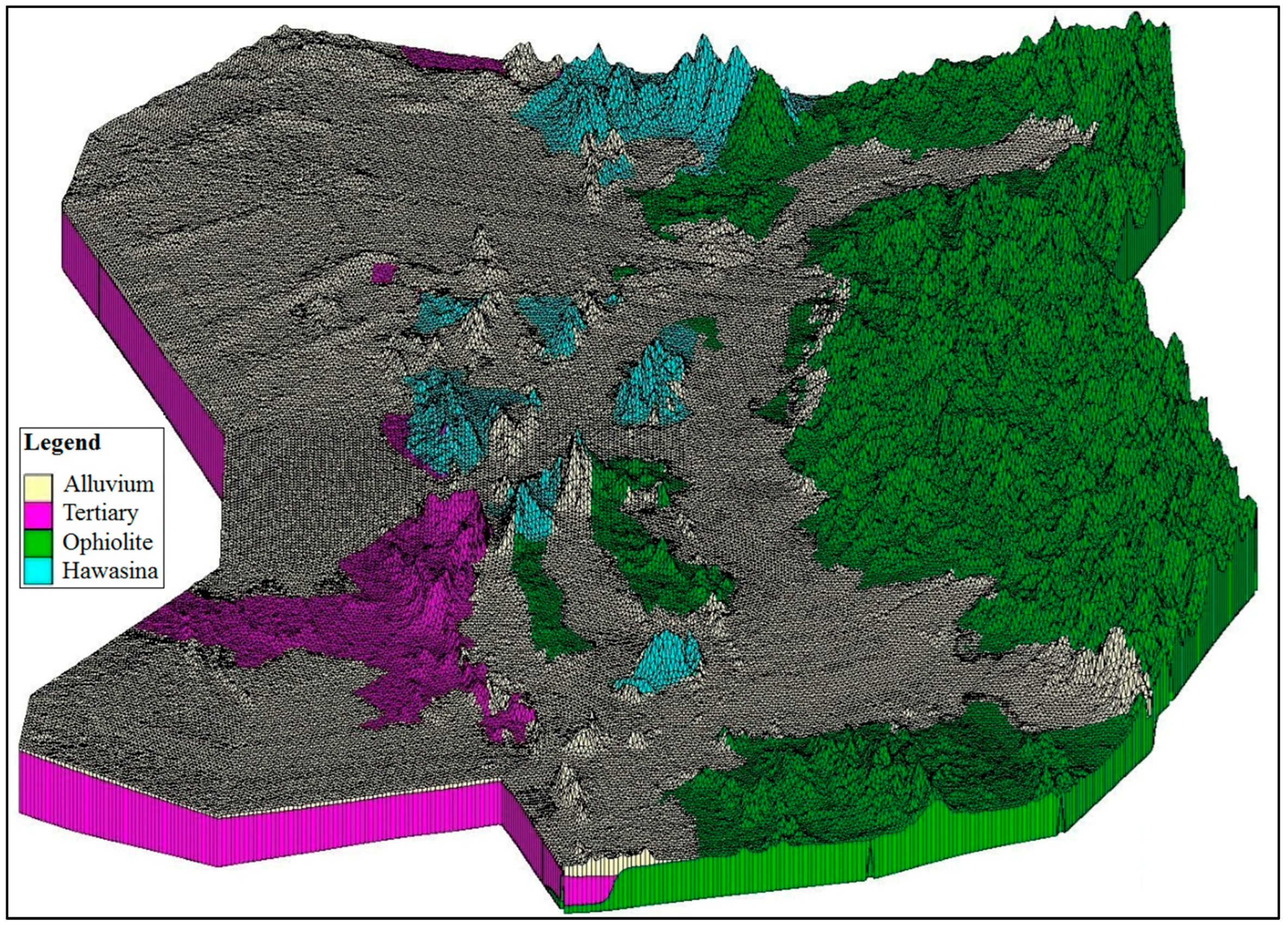
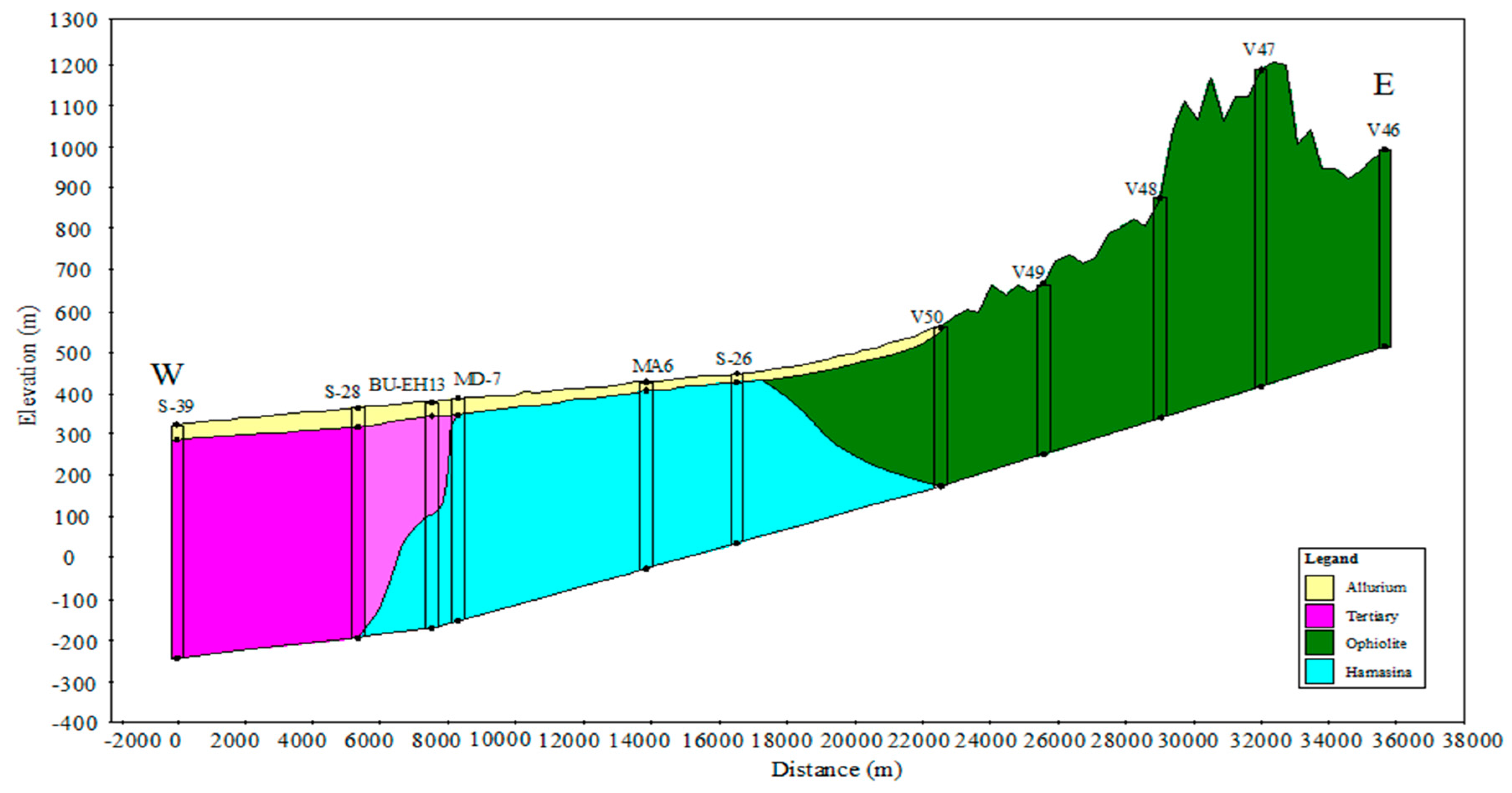
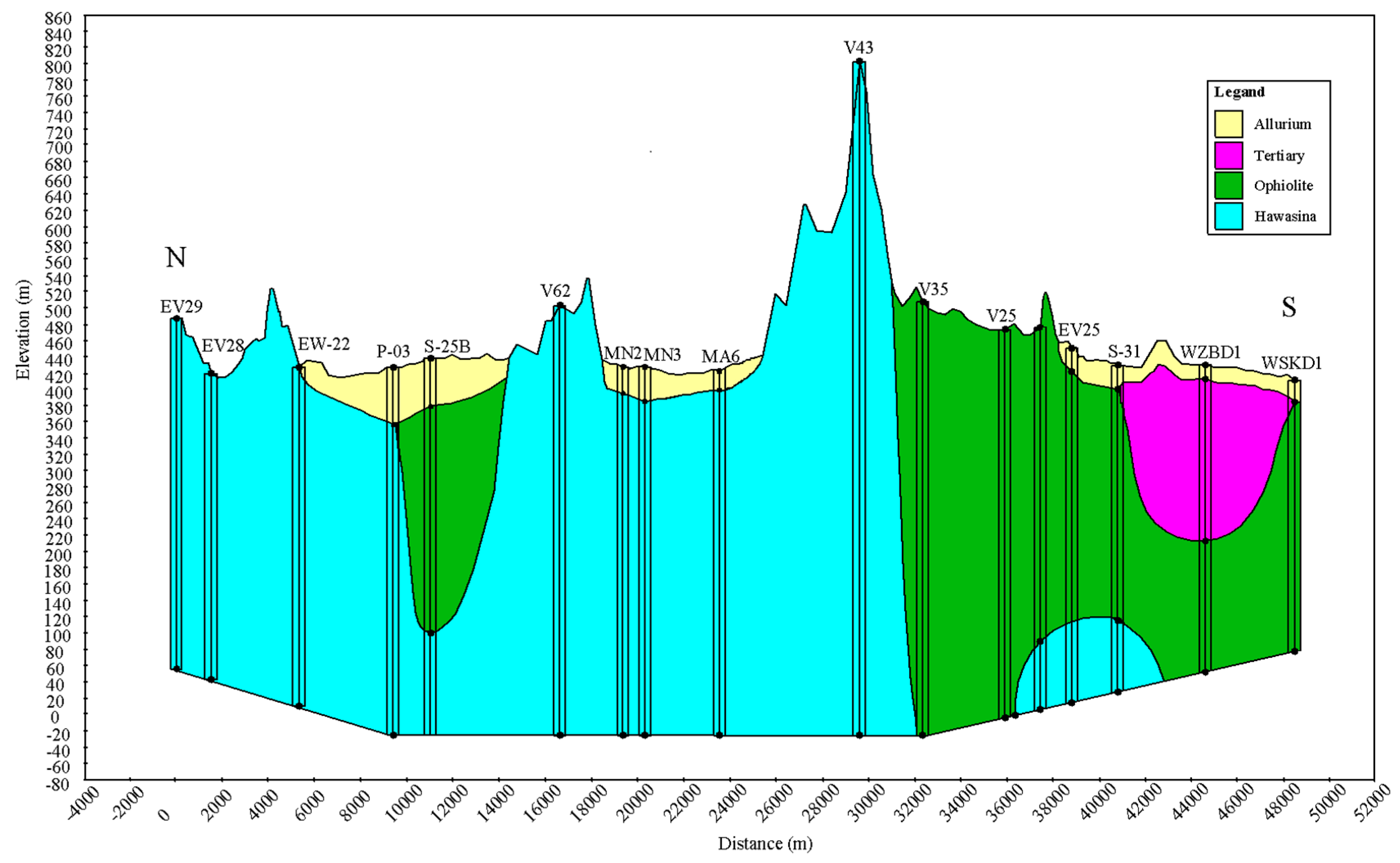
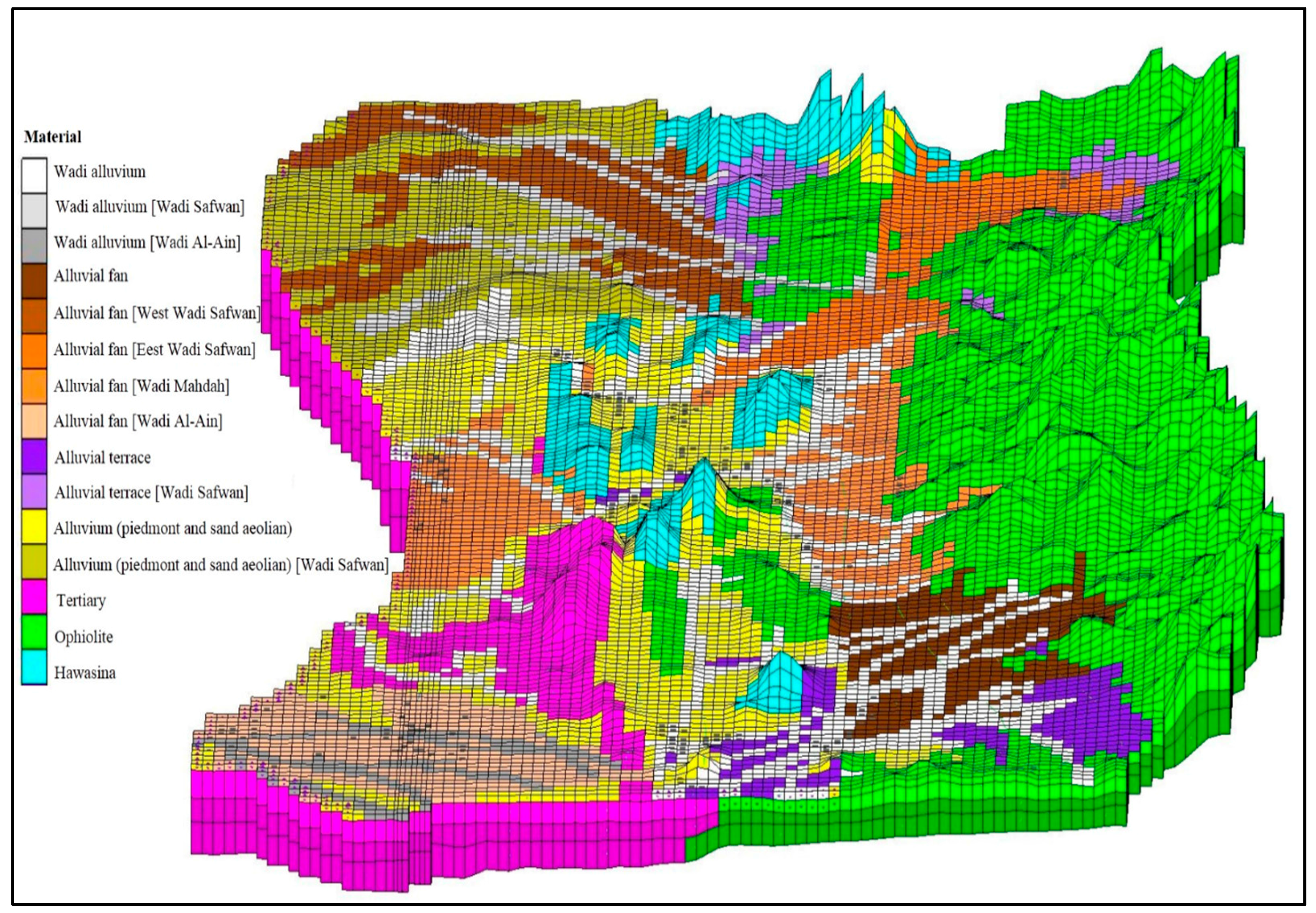
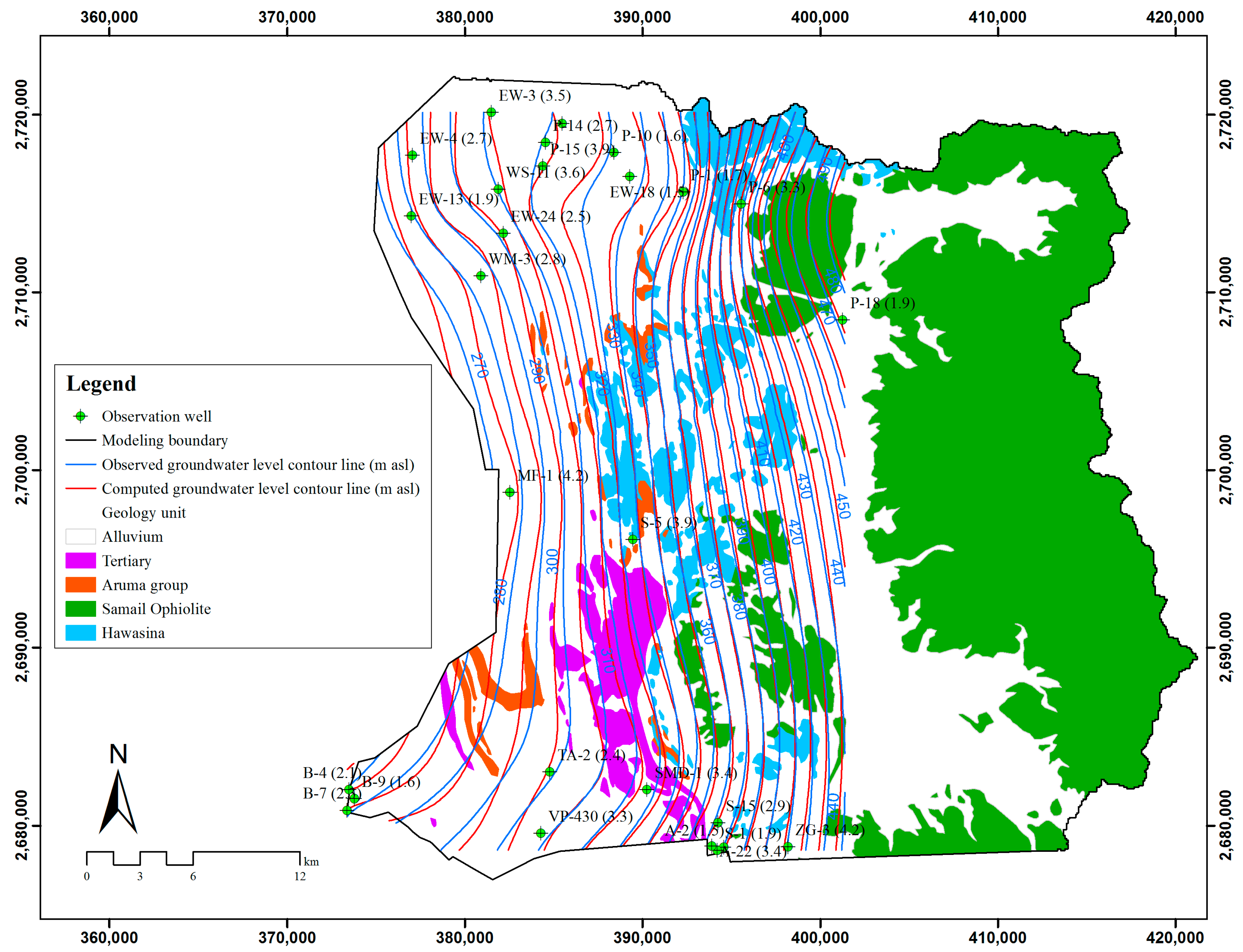
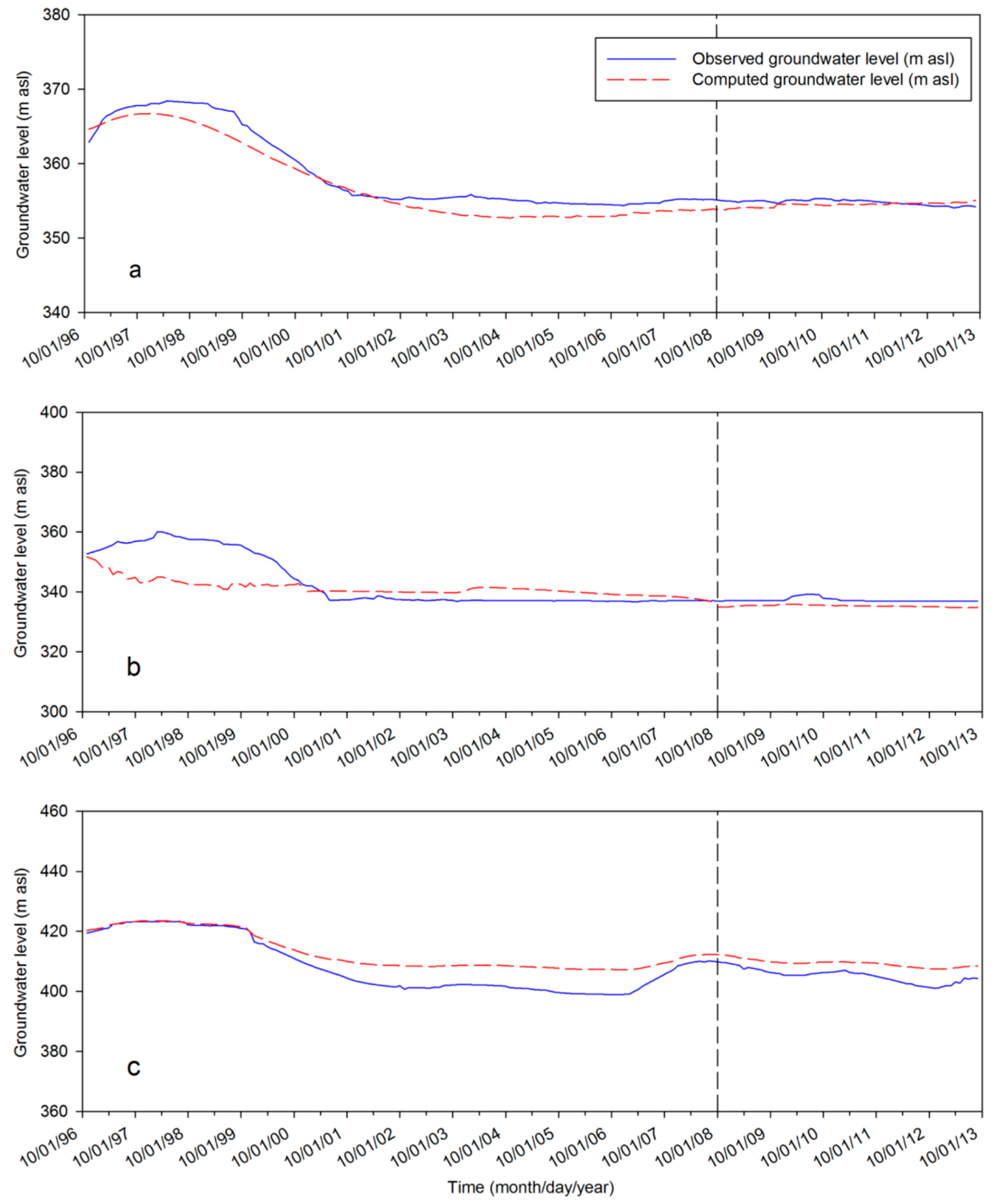
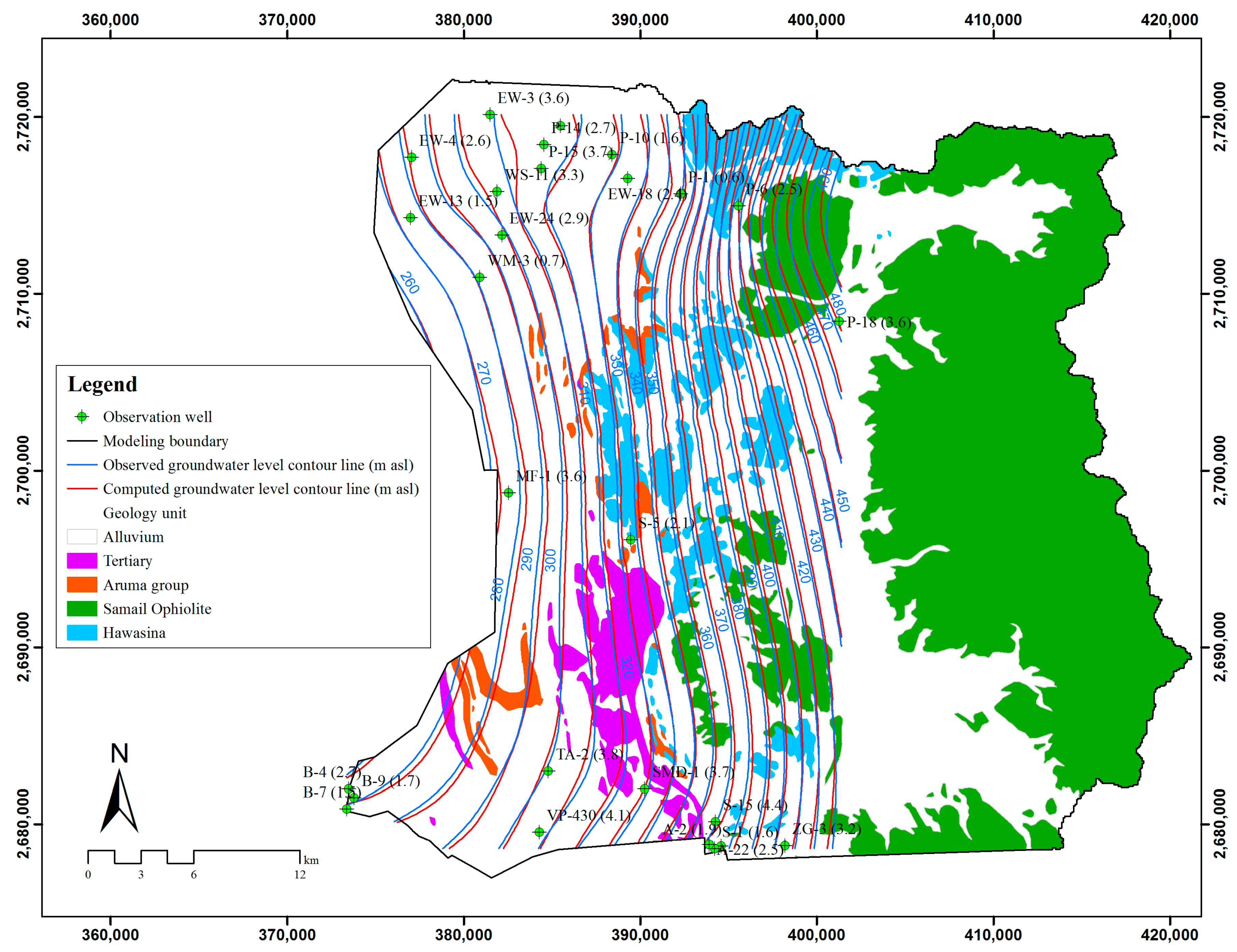
| Geological Unit | Hydraulic Conductivity (m/Day) | Specific Yield | Specific Storage (m−1) | |||
|---|---|---|---|---|---|---|
| HK * | Range | Sy | Range | Ss (m−1) | Range | |
| Wadi alluvium | 126 | 63–146 | 0.082 | 0.01–0.15 | 2.90 × 10−5 | 1.0 × 10−5–4.0 × 10−4 |
| Wadi alluvium (Wadi Safwan) | 107 | 63–146 | 0.150 | 0.01–0.15 | 4.06 × 10−5 | 2.90 × 10−5–4.0 × 10−4 |
| Wadi alluvium (Wadi Al-Ain) | 116 | 63–146 | 0.093 | 0.01–0.15 | 2.90 × 10−5 | 2.90 × 10−5–4.0 × 10−4 |
| Alluvial fan | 44.8 | 27–55 | 0.045 | 0.01–0.15 | 1.74 × 10−5 | 2.90 × 10−5–4.0 × 10−4 |
| Alluvial fan (West Wadi Safwan) | 22.7 | 27–55 | 0.130 | 0.01–0.15 | 2.90 × 10−5 | 2.90 × 10−5–4.0 × 10−4 |
| Alluvial fan (East Wadi Safwan) | 39.9 | 27–55 | 0.130 | 0.01–0.15 | 2.90 × 10−5 | 2.90 × 10−5–4.0 × 10−4 |
| Alluvial fan (Wadi Mahdah) | 35.0 | 27–55 | 0.076 | 0.01–0.15 | 2.90 × 10−5 | 2.90 × 10−5–4.0 × 10−4 |
| Alluvial fan (Wadi Al-Ain) | 44.1 | 27–55 | 0.106 | 0.01–0.15 | 2.90 × 10−5 | 2.90 × 10−5–4.0 × 10−4 |
| Alluvial terrace | 34.3 | 9–45 | 0.034 | 0.01–0.15 | 1.74 × 10−5 | 2.90 × 10−5–4.0 × 10−4 |
| Alluvial terrace (Wadi Safwan) | 14.7 | 9–45 | 0.120 | 0.01–0.15 | 2.90 × 10−5 | 2.90 × 10−5–4.0 × 10−4 |
| Alluvium (piedmont and sand dune) | 7.3 | 9–35 | 0.035 | 0.01–0.15 | 3.11 × 10−5 | 2.90 × 10−5–4.0 × 10−4 |
| Alluvium (piedmont and sand dune) (Wadi Safwan) | 11.2 | 9–35 | 0.120 | 0.01–0.15 | 2.90 × 10−5 | 2.90 × 10−5–4.0 × 10−4 |
| Tertiary | 3.11 (3.60 × 10−5) ** | 1–4 | 0.001 | 0.0006–0.0014 | 3.74 × 10−4 | 6.0 × 10−5–1.4 × 10−4 |
| Ophiolite | 1.12 (1.30 × 10−5) | 0.08–2 | 0.001 | 0.0006–0.0014 | 4.50 × 10−4 | 6.0 × 10−5–1.4 × 10−4 |
| Hawasina | 0.0009 (1.0 × 10−8) | 8.60 × 10−7–8.60 × 10−5 | 0.001 | 0.0006–0.0014 | 1.0 × 10−5 | 6.0 × 10−5–1.4 × 10−4 |
| Period | Weighted RMSE (m) | Weighted R2 | NRMSE (%) |
|---|---|---|---|
| Calibration | 2.71 | 0.69 | 18 |
| Validation | 3.47 | 0.65 | 32 |
| Period | SPI Values * | Climate Condition | Inflow | Outflow | Balance | |
|---|---|---|---|---|---|---|
| QR ** | QAA ** | Qout ** | ±ΔV | |||
| October 1996–September 1997 | 1.56 | Wet | 43.94 | 35.02 | 40.07 | −31.15 |
| October 1997–September 1998 | 0.66 | Normal | 19.62 | 32.96 | 41.31 | −54.65 |
| October 1998–September 1999 | −0.36 | Normal | 15.13 | 31.39 | 40.79 | −57.05 |
| October 1999–September 2000 | −2.47 | Dry | 15.19 | 31.55 | 43.35 | −59.71 |
| October 2000–September 2001 | −1.80 | Dry | 14.91 | 30.16 | 44.81 | −60.06 |
| October 2001–September 2002 | −1.49 | Dry | 15.09 | 27.18 | 40.79 | −52.88 |
| October 2002–September 2003 | −1.31 | Dry | 14.98 | 25.96 | 38.54 | −49.52 |
| October 2003–September 2004 | −1.20 | Dry | 15.15 | 26.55 | 38.08 | −49.48 |
| October 2004–September 2005 | 0.63 | Normal | 18.17 | 26.81 | 31.57 | −40.21 |
| October 2005–September 2006 | 0.48 | Normal | 15.38 | 25.99 | 29.92 | −40.53 |
| October 2006–September 2007 | 1.22 | Wet | 28.07 | 26.09 | 26.71 | −24.73 |
| October 2007–September 2008 | 0.61 | Normal | 13.57 | 25.06 | 27.87 | −39.36 |
| October 2008–September 2009 | −1.31 | Dry | 11.76 | 25.32 | 25.57 | −39.13 |
| October 2009–September 2010 | 0.82 | Normal | 21.20 | 23.88 | 23.47 | −26.15 |
| October 2010–September 2011 | −0.16 | Normal | 13.72 | 24.08 | 27.52 | −37.88 |
| October 2011–September 2012 | 0.02 | Normal | 15.56 | 23.10 | 19.71 | −27.25 |
| October 2012–September 2013 | 0.83 | Normal | 16.20 | 23.01 | 17.38 | −24.19 |
| 17-year average | - | - | 18.09 | 27.3 | 32.79 | −41.99 |
| Period | Qbf |
|---|---|
| October 1996–September 1997 | 11.69 |
| October 1997–September 1998 | 7.79 |
| October 1998–September 1999 | 6.31 |
| October 1999–September 2000 | 6.04 |
| October 2000–September 2001 | 5.80 |
| October 2001–September 2002 | 5.51 |
| October 2002–September 2003 | 5.30 |
| October 2003–September 2004 | 5.14 |
| October 2004–September 2005 | 5.11 |
| October 2005–September 2006 | 6.09 |
| October 2006–September 2007 | 4.87 |
| October 2007–September 2008 | 4.64 |
| October 2008–September 2009 | 4.50 |
| October 2009–September 2010 | 4.68 |
| October 2010–September 2011 | 4.34 |
| October 2011–September 2012 | 4.40 |
| October 2012–September 2013 | 4.23 |
| 17-year average | 5.67 |
© 2017 by the authors. Licensee MDPI, Basel, Switzerland. This article is an open access article distributed under the terms and conditions of the Creative Commons Attribution (CC BY) license ( http://creativecommons.org/licenses/by/4.0/).
Share and Cite
Izady, A.; Abdalla, O.; Joodavi, A.; Chen, M. Groundwater Modeling and Sustainability of a Transboundary Hardrock–Alluvium Aquifer in North Oman Mountains. Water 2017, 9, 161. https://doi.org/10.3390/w9030161
Izady A, Abdalla O, Joodavi A, Chen M. Groundwater Modeling and Sustainability of a Transboundary Hardrock–Alluvium Aquifer in North Oman Mountains. Water. 2017; 9(3):161. https://doi.org/10.3390/w9030161
Chicago/Turabian StyleIzady, Azizallah, Osman Abdalla, Ata Joodavi, and Mingjie Chen. 2017. "Groundwater Modeling and Sustainability of a Transboundary Hardrock–Alluvium Aquifer in North Oman Mountains" Water 9, no. 3: 161. https://doi.org/10.3390/w9030161






